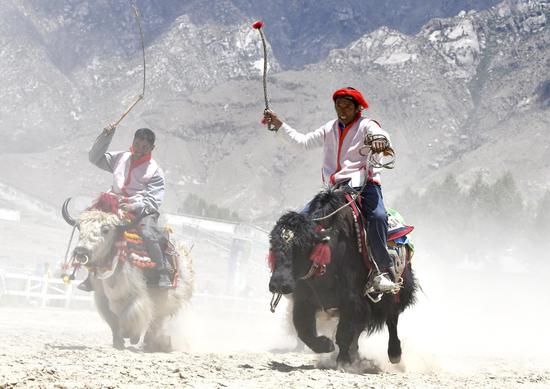
Many of the bones recovered from Baishiya Karst Cave, like this spotted hyena atlas, contain traces of human activities such as cut marks. (Photo/Courtesy of Zhang Dongju's Group from Lanzhou University)
A new study has made significant progress in the research into Denisovans, an extinct hominin group, revealing that Denisovans survived on the Qinghai-Tibet Plateau as late as approximately 40,000 years ago, the Global Times learnt from the Institute of Tibetan Plateau Research, Chinese Academy of Sciences (CAS) on Thursday.
The study was led by researchers from Lanzhou University, the University of Copenhagen, and the Institute of Tibetan Plateau Research, CAS, which indicates how adaptable the Denisovans were to the plateau environment, according to the researchers. The study was published in the journal Nature on Wednesday.
"Our results shed light on the behavior of Denisovans and their adaptations to the diverse and fluctuating environments of the late Middle and Late Pleistocene of eastern Eurasia," the researchers wrote in the study published on Nature.
The researchers studied more than 2,500 bones from the Baishiya Karst Cave (3,280 meters above sea level) on the high-altitude Qinghai-Tibet Plateau, one of the few known locations where Denisovans lived.
"Most of the bone fragments from Baishiya Karst Cave are too fragmented to identify species morphologically by zooarchaeology," said Wang Jian, co-first author from Lanzhou University. The team used a proteomic screening method called Zooarchaeology by Mass Spectrometry (ZooMS) to determine the species, according to the researchers.
"ZooMS allows us to extract valuable information from often overlooked bone fragments, providing deeper insight into human activities," said Xia Huan, co-first author from Lanzhou University.
Using ZooMS, the researchers identified a new hominin rib specimen that dated to approximately 48,000 to 32,000 years ago.
At the same time, more than 20 vertebrate species were identified, including herbivores such as blue sheep, wild yak and the extinct woolly rhino, carnivores such as snow leopard and the locally extinct spotted hyena, small mammals, and birds.
"Large amounts of bone remains were found in the cave. The diverse species identified partly answer the questions why Denisovans chose to live in Baishiya Karst Cave and the surrounding Ganjia Basin, and how they survived there for hundreds of thousands of years," said Zhang Dongju, who co-led the research teams, and is also a professor at Lanzhou University.
"The long occupation of Denisovans at Baishiya Karst Cave, from the late Middle Pleistocene to the late Late Pleistocene, provided a good base for them to adapt to the high elevation environment characteristic of the Qinghai-Tibet Plateau," according to Chen Fahu, a fellow researcher with the Institute of Tibetan Plateau Research, CAS and a CAS academician, who co-led the research teams.
The Baishiya Karst Cave in Northwest China's Gansu Province is a popular tourist spot. In the 1980s, a fossil jawbone was found in the cave by a monk. Further archaeological surveys have been conducted during recent years.


















































 京公网安备 11010202009201号
京公网安备 11010202009201号